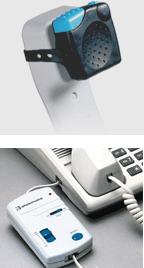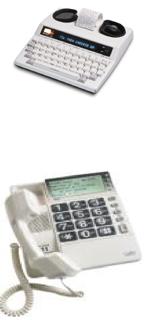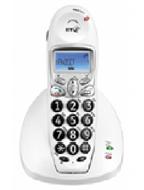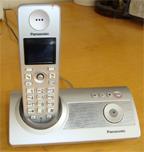 |
|||||||||
 |
|||||||||
Services > Changing Your Telephone This is a long factsheet. If you prefer to download it as a pdf, please click here • Introduction Hard of hearing people often have problems using the telephone.This can sometimes be overcome by using different techniques - BT's fact-sheet Sound Connections describes them. However, sometimes the only solution is new equipment and this fact-sheet tells you what sort of equipment is available and where you can purchase it. The following are covered: Changing your telephone Useful information: Table 1: Telephones for hard of hearing users This day and age, it’s quite easy to change your telephone and phones with amplification and inductive coupling need not be very expensive. Your service provider (e.g. BT or NTL) supplies a fixed socket or sockets in the home and you simply plug in your new phone and set it up. If you have the old type box where the phone is permanently fixed, your supplier may change this to the new type socket although there may be a charge for this service. You don't have to rent or purchase a telephone from your service provider. A variety of telephones are on offer at many superstores. However, assuming that you need a phone with some adaptation such as inductive coupling, you may find that the assistants are not very knowledgeable. One important issue is that you should be able to try-before-you-buy to make sure that the chosen equipment is suitable for your particular hearing needs. Consider, also, asking hard of hearing friends how they get on with their phone or visiting your nearest local resource centre/ disabled living centre where telephones are available to see and try. You can find a listing of centres where you can try before you buy on BT’s website www.bt.com/inclusion. Many of the organisations that sell telephones for hard of hearing people will sell you a phone on the basis of accepting a return if it proves unsatisfactory. There is usually a time limit to this. If you buy from a normal outlet, make sure you say how you wish to use the phone (eg with a hearing aid set to T). Then you should be able to return the unit if it does not prove satisfactory. If you have tried the techniques in Sound Connections but struggle to hear or you find that people seem to mumble when speaking to you, you have to consider new equipment. If your hearing loss is not too severe, you may find that an amplifier helps (see separate amplifiers) and this is a low cost solution. Very often, the best solution is to change your phone to one with a speech amplifier and volume control. You may also find that a phone with tone or “clarity” control helps. Such phones are capable of overcoming quite pronounced hearing loss. For more information, go to the section on special telephones. If your phone has inductive coupling as well as an amplifier and volume control, these can also be used to increase the speech volume further when using your hearing aid on ‘T’. If you have an MT position on your aid, you can make full use of both microphone and telecoil. If you decide that you just need a boost of volume or use of an inductive coupler, rather than change your phone you might find a separate amplifier useful and cheaper.
An ‘earpiece amplifier’ simply fits over the handset earpiece and is held by an elastic strap. These amplifiers usually have both volume control and inductive coupling. You can take it with you for use with any phone. However, it can be a fiddle fixing the amplifier when a call arrives.
An ‘in-line amplifier’ can be used if your handset plugs into the telephone (as most modern ones do) and becomes a part of your telephone. You simply unplug the handset, plug the amplifier in its place and then plug the handset into a socket on the amplifier. You should unplug the telephone from the house system whilst you do all this. If your loss is severe, the amplifier may have to boost the sound so much that it becomes distorted at the handset and you end up no better off. This is the time to consider buying a special telephone. Remember, of course, to keep an eye on the batteries. They are long lasting but, if they run out, you have no amplification! See Table 2 for some examples.
They may offer facilities such as very high volume, tone or clarity control, hands-free operation, the facility to add a headset, and easy to dial special numbers. Some are designed to help in other ways such as large buttons and speech repetition of dialled numbers. We have listed several available phones in table 1. • For those who need a little more – text based communication What is available for those who rely a lot on lip reading and find a voice telephone hard work and unreliable? Sound Connections describes the use of a headset and a friend as one way of getting over this. However, if this is impracticable or not sufficient, probably the best current solution is some form of text support.
One obvious solution is to get a text-phone or ScreenPhone (RNID) so that you can text directly with other text-phone users or use the relay service called Typetalk to communicate with hearing friends. Another text alternative is to use SMS(text) messaging that you get on a mobile phone. You can now get house phones that work with SMS. If you have a computer with Internet connection, you can use e-mail for messages that don’t need an instant response. If you want a text “conversation” then you need instant messaging (eg MSN Messenger) where you can type in text and get an instant response when connected and even an element of VoIP. With instant messaging, you and your contact need to be on the same system. In the future, you may be able to use “captioned telephony” as Hearing Concern LINK is campaigning for functionally equivalent relay services. Unfortunately, the only such service that was available in the UK – Captel – has had to close because of costs.
• Hands-free or loudspeaking phones Some telephones feature ‘loudspeaking’ or ‘hands-free’ speech, allowing you to hold a conversation without holding the handset. This can be particularly helpful if you wear two aids, use a body-worn aid or have very severe hearing loss. You hear the speech through a speaker in the body of the phone and your voice is picked up through a microphone on the phone. This enables you to receive a ‘balanced’ sound, which many people find easier to hear. This also allows someone else to listen in and repeat important points for you to lip read. As the speech is broadcast into the room, there is no confidentiality but allows everyone present to share in, and contribute to, the conversation. Some phones also allow the handset earpiece to function when using the hands-free option so that, if you use a body-worn aid, you can hold the handset to the microphone on your body aid so that you can speak into the hands-free microphone while the earpiece is down on your chest. These phones usually use batteries to improve the quality of the broadcast speech. Some hands-free phones are designed to work without any additional batteries but rarely offer the same performance as battery-assisted phones. See Table 1 for telephones that offer hands-free.
DECT phones are probably the most popular in the home these days, they tend to have clearer sound as well as offering a range of facilities such as remembering phone numbers. However, DECT phones transmit interference to hearing aids just as mobile phones do. In some circumstances, digital hearing aids may be immune to this interference. However, sometimes a neck-loop (see Table 3) may be available. Very often DECT phones offer some volume control and hands-free operation and some are available with a built-in answering machine that allows you to listen to messages clearly through the hand-set. Analogue cordless phones tend to be larger than DECT phones, simpler to use and do not have a screen which displays the progress of the call among other features. Many analogue cordless phones have inductive couplers fitted and most have some volume adjustment. Some have built-in answering machines. Unfortunately, analogue phones are becoming outdated and you may have a lot of trouble finding one. See Table 1 for some DECT phones designed for hard of hearing users and some analogue cordless phones with inductive coupling
Many mobiles offer some volume control and hands-free operation. Of course, you can also use SMS text messaging on a mobile. The adaptive devices essentially allow the mobile phone to be held away from the ear so that hearing aid interference due to the mobile phone radiation is minimised. They are currently either “loopset” (neck-loop) or “hands free” devices. All the devices make use of the hearing aid inductive coupler so that they have the added advantage of eliminating ambient noise and making the incoming speech clearer. Most have a built in microphone that is often very convenient and an aid to privacy. Performance depends on the characteristics of the mobile phone as well as the characteristics of the hearing aid as they interact with the device, so you really have to try a device with your hearing aid and mobile phone to see if the set-up is suitable. Price is not necessarily a guide to best performance. If you had a normal hands-free set supplied with your phone it may be worthwhile trying this before you buy a special adaptive device. If you place the earpiece next to your hearing aid, it may just generate sufficient inductive signal to operate your hearing aid’s inductive coupler. Not everyone finds an adaptive device convenient. You do have to carry around an extra bit of wire all the time and it takes time to plug in and set up when you have an incoming call. However, for outgoing calls, especially from a noisy area, a suitable adaptive device can make all the difference – especially if you have analogue hearing aids. “Bluetooth” enabled mobiles are now commonplace. These have a wireless connection between the mobile and a special headset for hands-free, no wires use. However, they are not designed for hearing aid users but may offer a solution that suits particular needs. One can purchase inductive coupled neck-loops or ear-hooks that make a Bluetooth connection to a mobile phone. We shall probably see developments on this in the future so, for example, Oticon offers a hearing aid that includes a Bluetooth pendant whilst Starkey offer a hearing aid plug-in and Bluetooth pendant (ELI DirX at about £240). • Internet-based phones – VoIP & Skype In commerce, many telephone systems make use of the internet and this is also available for household use. The generic name is “Voice over Internet Protocol” (VoIP). The major provider for household use is Skype but there are many VoIP service providers. Usually, once you have bought the special equipment and set up an internet connection, calls are free to anyone with the same provider and at greatly reduced prices to other phone users so VoIP is valuable for those who wish to talk regularly to contacts abroad. Hearing Concern LINK has done no testing but most would say that the clarity of VoIP calls is not the best and there can be speech delays. However, one can set up a neck-loop with many systems. Many answering machines have an indifferent message playback system and hard of hearing people often have trouble understanding the message. However, many telephones have a built-in answering machine that you can listen to through the An alternative is a network answering service such as BT 1571 Answer, which is free to BT users. This will allow you to hear callers’ messages via the hand-set using the telecoil and volume control as you would a normal call.
Many special telephones and cordless phones need connection to the mains supply. Therefore, if you have an emergency where the mains supply is broken, they will not work. It is important to keep one telephone that does not need mains power (normally a corded phone) specially for that sort of emergency. • How many phones can I have on one line? The amount of power that can come down the telephone line limits the amount of telephone equipment on a single line. The Ringer Equivalence Number (REN) measures the load a device places on a telephone line. A normal BT line will support a REN of about 4. In other words, several phones/fax/modems should work on a line so long as their REN figures added together don't exceed 4. A normal telephone usually has a REN of about 1, so that you should be able to have four phones on your line. However, fax machines and an internet connection also use up your REN total so it's quite easy to exceed the maximum which leads to problems such as your phone not ringing. You can buy a REN booster for about £30 which will allow about 8 REN to be used on one phone line. Try Connevans or RNID. Remember that a booster needs a mains supply so it's worth fitting one (non-mains) telephone before the booster to ensure telephone access in a power cut. • What if I can't hear the phone ring? A telephone isn't much use if you can't tell if someone is calling. However, there are various solutions. If the ring volume is only a bit too quiet, first of all, check your phone. Several telephones allow one to increase the ringer volume or change the tone. To get a much louder ring you can get a specially loud ring unit that plugs into a spare telephone socket. If you are on BT, you may be able to get one free. Otherwise, you can get one for from about £16 to £30 from Connevans or RNID.
Many mobile phones and some special phones have a vibration alert facility – see Table 1. To warn you wherever you are in the house, you can include the telephone in many house warning systems that indicate a caller at the door etc. These demand specialist installation and you are advised to read our fact-sheet on environmental aids. Some of this equipment may be available through your local Social Services office. The following tables give information on some currently available equipment and the names of specialist suppliers. Hearing Concern LINK cannot guarantee that this factsheet is 100% up to date but the suppliers should be able to tell you about the latest phones and prices. Some (e.g. RNID and Connevans) also publish detailed comparison charts. Hearing Concern LINK has not tested the equipment and cannot endorse specific products. All prices are approximate and intended only as a guide. • Table 1: Some telephones for hard of hearing people
*The BT Freestyle and Panasonic phones are “mainstream” phones and available from a variety of sources including the internet. Likewise some of the other phones. Most have amplification and all (apart from most DECT phones) have inductive coupling. The amplification available (usually given in dB) varies between phones and you should check this when selecting your phone if volume is vital. Only the briefest of details here. Many have extra facilities such as flashing light for incoming calls. Prices are approximate and without VAT. As a registered hard of hearing person, Customs and Excise rules often allow you to buy without VAT. You need to check with your supplier as regards any particular telephone. The range of special telephones is always expanding and this is just a selection of the main manufacturers and some of their range. We suggest you use supplier websites to get up-to-date information. We recommend the RNID booklet “Solutions” for a detailed comparison of available telephones.
• Table 3 - mobile adaptive devices
• Table 4: Specialist suppliers In addition to the listed suppliers don’t forget the various local resource centres across the country of which you can try a range of products.
• Useful websites BT, Sound Connections: www.btplc.com/inclusion/phoneservices/products/clearer/soundconnections.htm BT, listing of resource centres: www.btplc.com/inclusion/phoneservices/outreach/resource/index.htm BT, Communications Solutions booklet: www.btplc.com/inclusion/phoneservices/products/comsol/index.htm
All information is correct to the best of abilities. Hearing Concern LINK is not responsible for any loss or grievance caused by factual inaccuracies in the information contained within this factsheet. If you are aware of any inaccuracies within this factsheet please e-mail us stating which factsheet and the passage that you feel might be incorrect |
||||||||||||||||||||||||||||||||||||||||||||||||||||||||||||||||||||||||||||||||||||||||||||||||||||||||||||||||||||||||||||||||||||||||||||||||||||||||||||||||||||||
 |
||||
 There are two basic types. Both need batteries.
There are two basic types. Both need batteries. Several companies now offer telephones specially designed for hard of hearing users. The very least that they will offer is inductive coupling and increased volume and volume control. The cheapest will cost little more than any other phone but those with many facilities cost more. Very often the increased cost is well worth it.
Several companies now offer telephones specially designed for hard of hearing users. The very least that they will offer is inductive coupling and increased volume and volume control. The cheapest will cost little more than any other phone but those with many facilities cost more. Very often the increased cost is well worth it.


 hand-set so that you can use available telecoil and volume facilities.
hand-set so that you can use available telecoil and volume facilities.